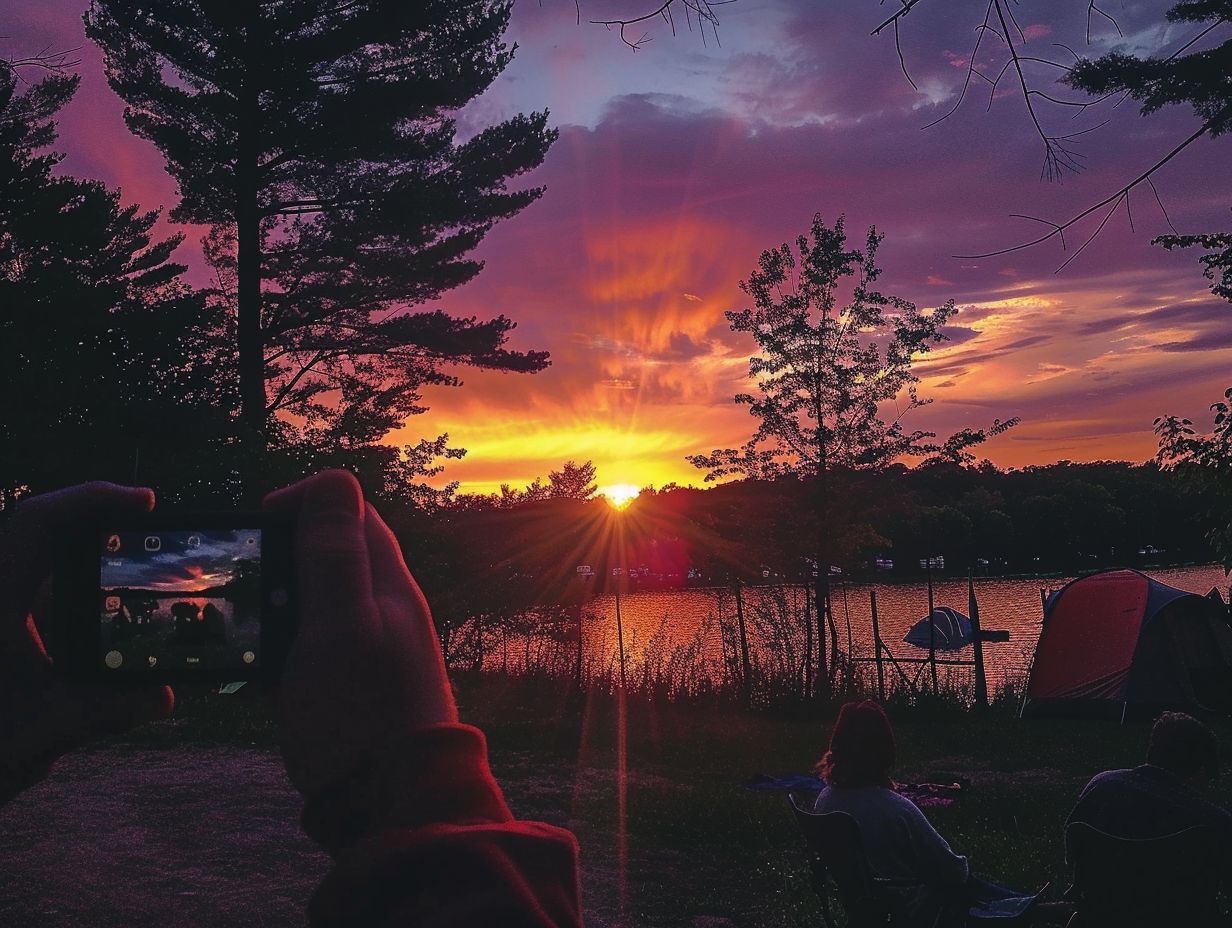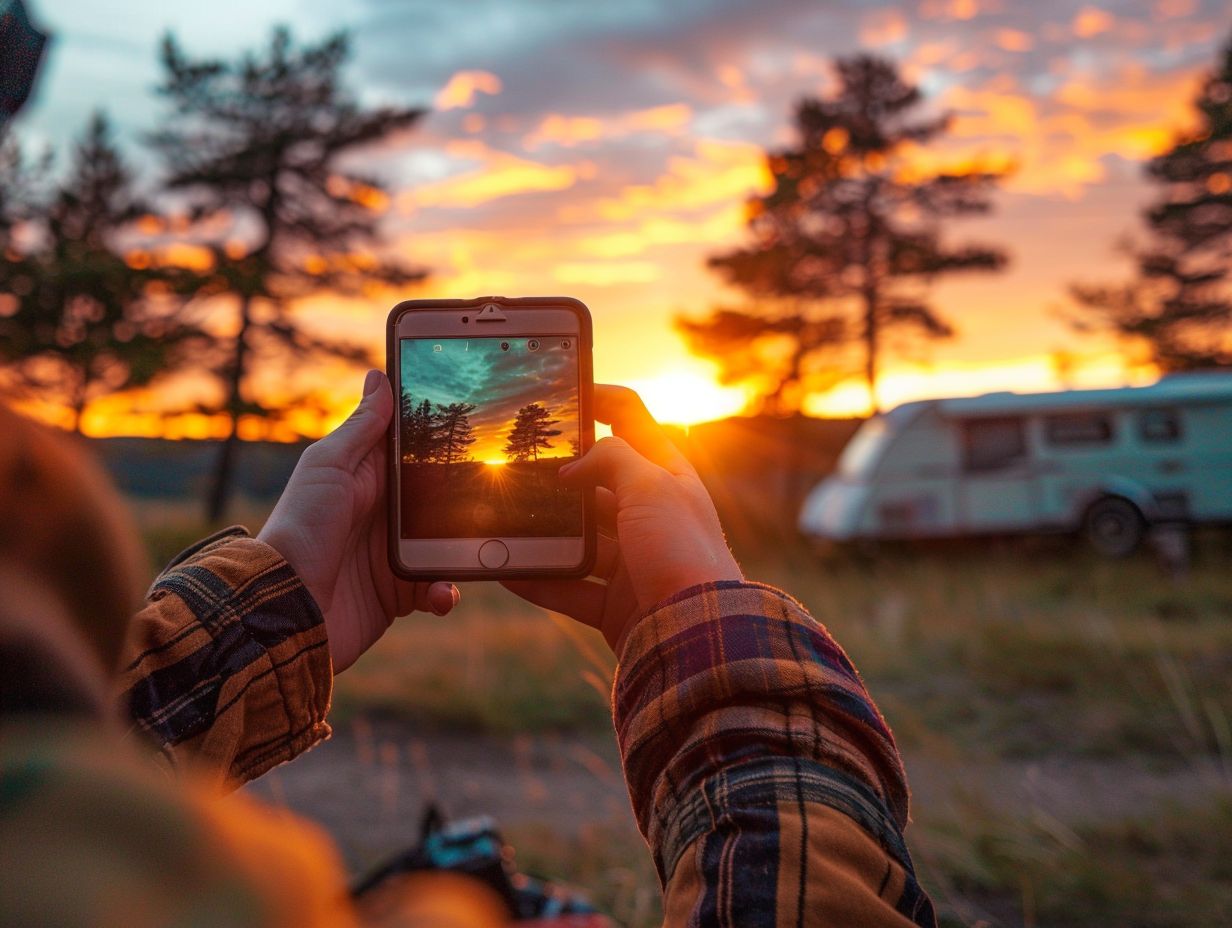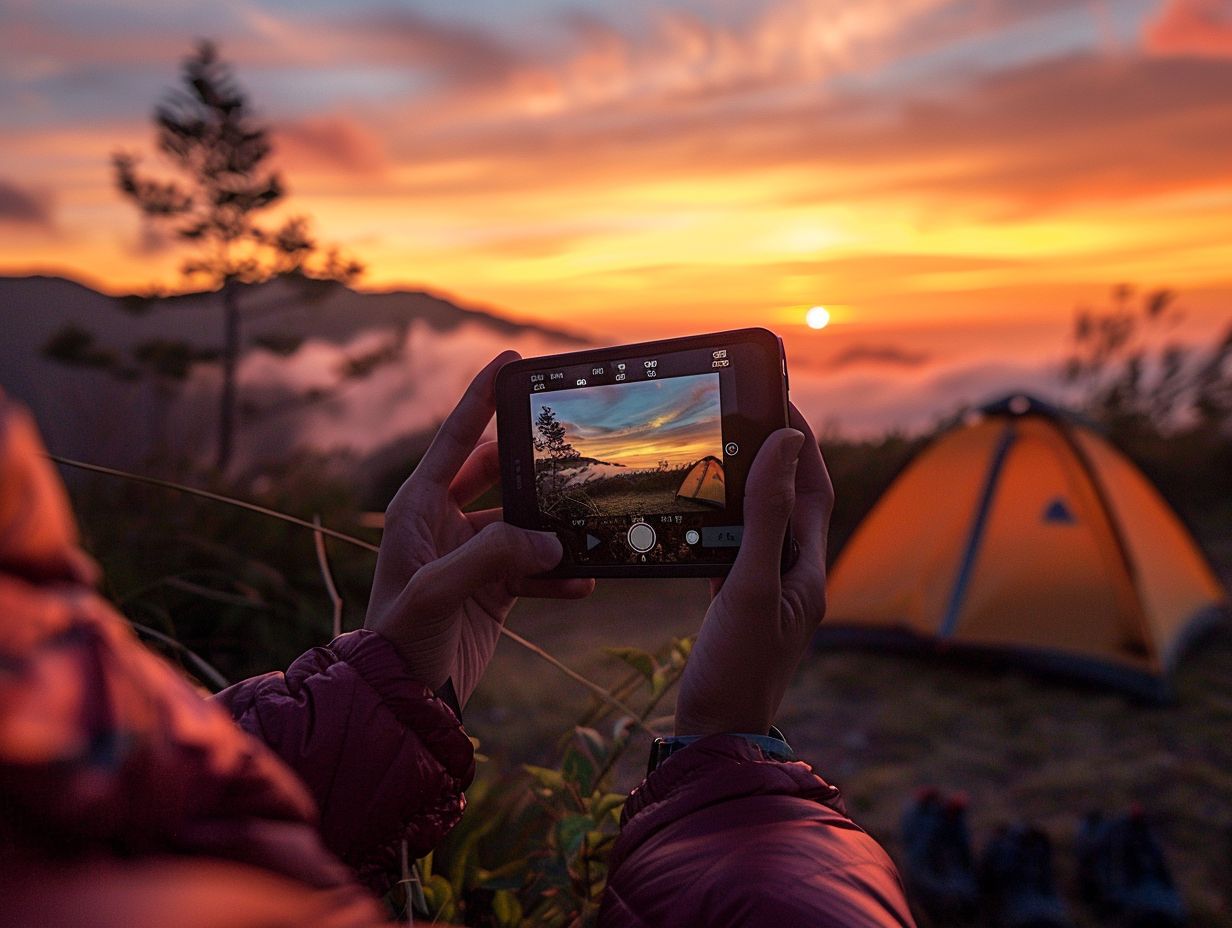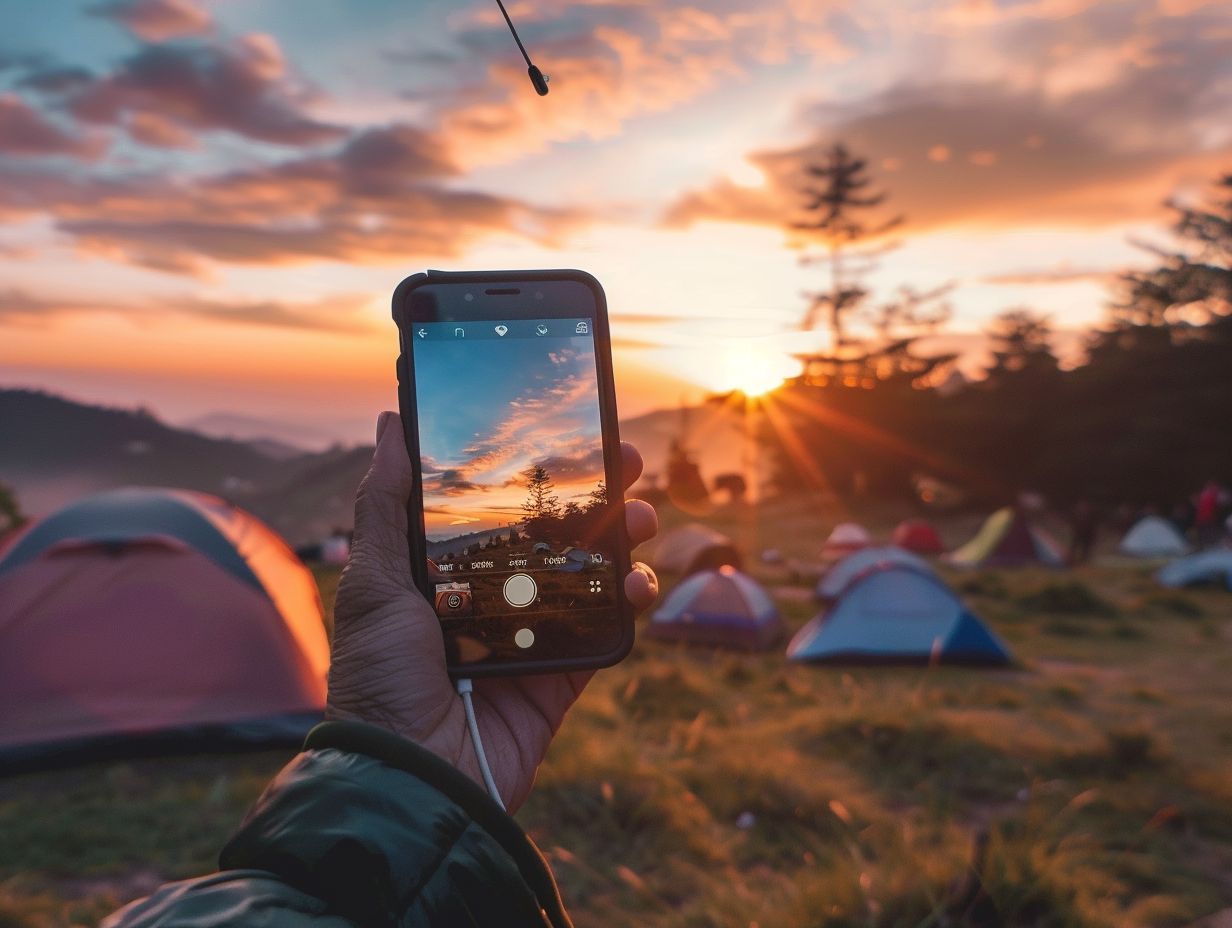If you are a photography enthusiast who enjoys spending time in the great outdoors, you will benefit from exploring these essential tips for capturing stunning photographs during your camping trips.
This comprehensive article delves into everything you require to elevate your camping photography skills, including selecting the appropriate camera and equipment, as well as integrating people into your images.
Prepare yourself by gathering your camera, packing your gear, and preparing to document your outdoor excursions in an unprecedented manner.
Key Takeaways:

- Choose the right camera and equipment for camping trips to ensure high-quality photos.
- Pack light and efficiently to make room for essential camping gear and to avoid getting weighed down.
- Plan shots ahead of time to make the most out of natural lighting and capture the best moments.
Choose the Right Camera and Equipment
When selecting the perfect camera and equipment for capturing memorable moments during camping and hiking, it is essential to choose wisely.
Whether opting for a high-tech digital camera such as the Olympus Tough or embracing the traditional charm of film cameras, ensuring the reliability of your gear, such as Otterbox Defender cases and Sandisk Extreme Pro cards, is paramount to safeguarding your memories.
When contemplating a camera for outdoor adventures, it is imperative to evaluate your photography requirements and preferences.
Digital cameras offer convenience with their immediate preview and editing capabilities, making them well-suited for documenting dynamic outdoor activities. On the contrary, film cameras deliver a distinct aesthetic and demand a more intentional approach to composition and exposure.
By complementing your camera with sturdy accessories like the Otterbox Defender case for protection against the elements and the high-speed Sandisk Extreme Pro cards for efficient storage, you can enhance your outdoor photography endeavors.
Pack Light and Efficiently
Efficient packing is crucial for a successful camping trip, particularly when hiking to remote destinations. Utilise a sturdy backpack to transport necessities such as layered clothing to adapt to changing temperatures, nutritious food supplies, and a robust tent for protection from the elements.
Layering clothing is essential for maintaining comfort in diverse weather conditions. Begin with a moisture-wicking base layer to prevent sweat from clinging to the skin, incorporate insulating layers for warmth, and finish with a waterproof and windproof outer shell.
In terms of food, prioritise lightweight yet nutrient-dense options like dehydrated meals, energy bars, nuts, fruits, and jerky. These portable selections offer sustained energy to meet the physical demands of hiking and camping excursions.
Plan Your Shots Ahead of Time
When preparing your photography shots in advance, consider the lighting conditions and experiment with different lenses to capture stunning images, especially during sunrise and sunset. Applying photography tips can further enhance the quality of your outdoor photographs.
In addition, planning your shots ahead of time can aid in scouting ideal locations for your camping and hiking adventures. By strategically selecting spots that offer beautiful natural backdrops and lighting, you can effortlessly elevate the visual appeal of your photographs.
Make use of the soft, warm hues of the sun during sunrise and sunset to imbue your images with a magical ambiance. Select wide-angle lenses for expansive landscapes and telephoto lenses for capturing intricate details of wildlife or distant scenery. By choosing the right lens, you ensure that your visual narratives are captured with precision and clarity.
Utilise Natural Lighting

You can elevate the quality of your camping and hiking photos by utilising natural lighting, especially during the enchanting hours of sunrise and sunset. Embracing the soft, warm sunlight can enable you to capture the essence of nature during its most captivating moments.
Within these golden hours, the light becomes softer and more diffused, creating a cosy and welcoming ambiance in your photographs. To enhance your sunrise and sunset shots, it is recommended to adjust your camera settings accordingly.
Consider using a lower ISO to minimise noise, a wide aperture to achieve a shallow depth of field, and slightly underexposing the images to preserve the details in the highlights.
Maximise the benefits of the golden hour by experimenting with composition techniques, integrating leading lines and framing elements, and capturing the dynamic interplay between light and shadow.
Capture the Scenery and Wildlife
Immerse yourself in the breathtaking scenery and diverse wildlife that camping and hiking adventures offer. Utilise your camera to capture the majestic landscapes, unique flora, and fascinating fauna encountered along the trails.
The vivid hues of sunrise painting the sky over rugged mountains, or the gentle dance of a deer in a sun-dappled clearing can make for enchanting photo opportunities. To capture the essence of these magical moments, practise patience and respect for the natural environment.
Position yourself thoughtfully to frame the perfect shot without disturbing the creatures. Remember, wildlife photography is about showcasing the beauty of animals in their element, so always maintain a safe distance and never disrupt their natural behaviours.
By blending artistry with mindfulness, you can preserve these precious encounters for a lifetime.
Experiment with Different Angles and Perspectives
Enhance your camping and hiking photography by exploring various angles and perspectives. To elevate the quality of your images, consider experimenting with different viewpoints. Embrace creativity by incorporating low angle views, bird’s eye perspectives, and macro shots into your repertoire.
When you capture a scene from a lower angle, you can present a distinctive and engaging perspective that highlights the grandeur of towering trees or majestic mountain peaks. Additionally, exploring bird’s eye views by ascending to a higher vantage point enables you to photograph expansive landscapes or intricate patterns found in nature.
For more detailed and intimate shots, delve into the world of macro photography. Focus on capturing close-up images of intricate details such as dewdrops on leaves or the textures of rocks. Remember, the composition plays a crucial role in the overall impact of your photographs.
Utilise techniques like leading lines, framing elements in the foreground, and adhering to the rule of thirds to craft visually compelling and well-balanced compositions.
Don’t Forget to Document the Campsite and Activities
Preserve cherished memories of camping experiences by documenting the campsite setup, outdoor activities, and moments shared with friends and family. Your photos can serve as a visual diary of the adventures and camaraderie enjoyed during your outdoor escapades.
Capturing candid moments amidst nature’s embrace is akin to freezing time – the crackling of the campfire, the shadows dancing on the tent walls, and the laughter echoing through the woods are all waiting to be immortalised through your lens.
Whether it’s a group cooking session under the stars or a serene sunrise over the lake, these snapshots not only record the beauty of the great outdoors but also encapsulate the connections formed as you toast marshmallows and swap stories by the fire.
Take Advantage of Golden Hour

Utilise the captivating golden hour light during sunrise and sunset for your camping and hiking photography. The soft, warm tones of the golden hour have the ability to elevate ordinary scenes into extraordinary compositions, imparting a magical essence to your outdoor photographs.
During the golden hour, the sun’s angle produces a soft, flattering light that accentuates textures and casts long, captivating shadows.
To fully leverage this unique lighting, position your subject towards the sun or experiment with backlighting to achieve a dreamy silhouette effect. Ensure to make adjustments to your white balance settings to accurately capture the warm hues.
The emotional resonance of golden hour photography is profound, eliciting feelings of tranquillity, nostalgia, and awe in viewers. These images often communicate a sense of calmness and beauty that can transport observers to a serene, harmonious setting.
Use a Tripod for Steady Shots
Ensure the stabilisation of your camping and hiking photos by utilising a reliable tripod to achieve steady shots and clear images. Whether you are capturing expansive landscapes or intricate details, a tripod provides the necessary stability and accuracy for your outdoor photography endeavours.
By incorporating a tripod into your photography equipment, you can effectively eliminate the risk of capturing blurry images caused by unsteady hands or uneven surfaces, resulting in the production of high-quality photographs.
When in the process of selecting a tripod, it is essential to assess factors such as weight capacity, height variability, and portability, tailoring your choice to the specific demands of your outdoor photography pursuits.
For landscape photography, opt for a robust and heavier tripod that can withstand strong winds and external elements, while a lighter and more compact option is better suited for hiking or situations that require minimal gear.
To fully optimise the functionality of your tripod, consider implementing techniques such as adjusting the legs to achieve diverse angles, employing a remote shutter release to minimise vibrations, and utilising the centre column for enhanced perspectives.
Don’t Be Afraid to Get Close and Personal
To create intimate and engaging camping and hiking photos, ensure to get up close and personal with your subjects. By capturing intricate details in nature or candid moments with fellow adventurers, proximity can add a sense of connection and emotion to your outdoor images.
When you zoom in on the delicate patterns of a leaf or capture the spark in someone’s eye as they gaze at a breathtaking vista, you are inviting viewers to experience the scene on a deeper level.
By paying attention to small gestures, textures, or expressions, you can transform a simple snapshot into a powerful narrative.
These close-up shots not only convey the beauty of the moment but also allow you to tell a more personal story through your photography, reflecting the raw emotions and genuine experiences of your outdoor journeys.
Incorporate People into Your Photos
Incorporate a human touch into your camping and hiking photography by including people in your photos. Whether you are capturing candid moments of camaraderie around the campfire or highlighting the grandeur of majestic landscapes with human subjects, integrating people into your outdoor images adds a relatable and dynamic element.
When composing photographs with individuals in outdoor settings, it is important to consider the rule of thirds to effectively position your subjects within the frame.
For group photos, strive to establish a sense of connection and intimacy by fostering natural interactions. Pay close attention to lighting, as backlighting can produce a stunning halo effect around silhouetted figures.
To convey a sense of scale, place hikers or campers in the foreground of expansive landscapes. Experiment with various angles and perspectives to capture authentic emotions and narrative moments during your outdoor excursions.
Keep Your Camera Protected and Safe

Ensure the safety and longevity of your camera during camping and hiking adventures by utilising dependable protective gear such as Otterbox Defender and Griffin Survivor.
These sturdy cases serve the purpose of shielding your camera from dust, water, and impacts, thereby ensuring the safety of your equipment in challenging outdoor conditions.
These rugged cases not only provide robust protection but also grant you peace of mind, allowing you to concentrate on capturing unforgettable moments without the worry of camera damage.
To further enhance the protection of your camera during outdoor excursions, it is advisable to consider investing in a lens protector to prevent scratches and smudges.
Additionally, remember to store your camera in a dry, secure location when not in use to prevent unnecessary exposure to moisture and extreme temperatures.
Edit and Enhance Your Photos
Enhance the visual impact of your camping and hiking photos by editing and enhancing them with post-processing tools. Fine-tune the colours, contrast, and composition of your images to create captivating visuals that reflect the beauty and essence of your outdoor adventures.
By utilising post-processing techniques, you can transform ordinary outdoor snapshots into stunning works of art. Software tools such as Adobe Lightroom and Photoshop offer powerful features for adjusting exposure, saturation, and sharpness, allowing you to emphasise the natural beauty of your surroundings.
Techniques like HDR blending and panorama stitching enable you to capture the expansive landscapes and breathtaking vistas of your hiking and camping excursions with precision and detail. Editing not only enhances the overall quality of your photos but also provides endless creative possibilities for storytelling and emotional expression in your visual narratives.
Share Your Photos and Memories
Share the joys and wonders of your camping and hiking experiences by showcasing your photos and memories on social media platforms such as Instagram, Facebook, and Twitter.
Create a visual narrative of your outdoor escapades and engage with like-minded enthusiasts through photography blogs or a dedicated YouTube channel.
Connecting with a photography community online not only allows you to share your outdoor adventures but also opens up opportunities for inspiration and collaboration. By interacting with fellow photographers, you can exchange tips, learn new techniques, and even participate in photo challenges.
Building a strong presence on platforms like Instagram, Facebook, Twitter, and YouTube can help you reach a wider audience and gain recognition for your work.
To create engaging content, focus on storytelling through your photos, use relevant hashtags to increase visibility, and interact with your followers by responding to comments and messages.
Enjoy the Moment and Don’t Focus Too Much on Photography
Whilst engaging in photography can be a valuable method for preserving memories, it is important to remain fully present in your camping and hiking experiences.
Ensure that the pursuit of capturing images does not overshadow your ability to appreciate the natural beauty, tranquillity, and exciting moments that unfold during your outdoor adventures.
Take the opportunity to pause and absorb the fresh air, the gentle rustling of leaves, and the solidity of the earth beneath your feet.
By staying focused on the present moment, you can deeply observe nature’s intricate elements – the interplay of sunlight with the foliage, the distant calls of birds, or the refreshing sensation of a gentle breeze on your skin.
Through deliberate observation and engagement of your senses, you can establish a genuine connection with the environment surrounding you, fostering enduring memories that extend beyond mere photographic documentation.
Frequently Asked Questions
What type of camera is best for camping trips?
The best camera for camping trips is one that is compact, lightweight, and durable. Look for cameras that are waterproof, shockproof, and have good battery life. Mirrorless cameras and compact point-and-shoot cameras are great options for camping trips.
What are some good composition tips for camping photography?
When taking photos on camping trips, try to incorporate the surrounding nature into your composition. Use the rule of thirds, leading lines, and natural framing to create interesting and visually appealing images. Also, be mindful of the lighting and time of day to capture the best shots.
How can I protect my camera while on a camping trip?
To protect your camera while camping, invest in a good quality camera bag or case. Make sure to store it in a dry and safe place when not in use. Consider using a UV or polarizing filter to protect the lens from dust and scratches. Also, be mindful of extreme temperatures and keep your camera away from water and heat sources.
What are some unique photo opportunities on camping trips?
Camping trips offer a plethora of unique photo opportunities, including wildlife, landscapes, and starry night skies. Look for interesting textures, patterns, and colors in nature. You can also experiment with long exposure techniques to capture the movement of water or stars.
How can I improve my photography skills on camping trips?
Practice makes perfect, so the best way to improve your photography skills on camping trips is to take lots of photos. Experiment with different settings, angles, and compositions. Don’t be afraid to try new techniques and always be on the lookout for interesting and unique photo opportunities.
What are some essential photography accessories to bring on a camping trip?
Some essential photography accessories to bring on a camping trip include extra batteries, a tripod, lens filters, and a remote shutter release. These will help you capture better images and ensure your camera is always ready for use. It’s also a good idea to bring a cleaning kit to keep your camera and lenses free from dust and dirt.



